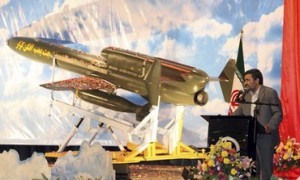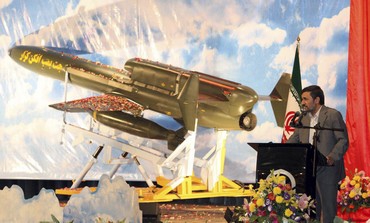 Iran�s Deputy Minister of Science, Research and Technology said on Monday that the Islamic Republic is exporting its domestically made drones and UAV technologies to a number of countries including Syria and Venezuela.
Iran�s Deputy Minister of Science, Research and Technology said on Monday that the Islamic Republic is exporting its domestically made drones and UAV technologies to a number of countries including Syria and Venezuela.Mohammad Mehdinejad-Nouri told students at Iran�s Babol Noshirvani University of Technology in the northern province of Mazandaran that the exports were a result of the significant advances Iran has made in drone technology, which have made the Islamic Republic a leader in designing and operating unmanned aircraft, Iran�s ISNA news agency reported.
The claims come a day after the commander of Iran�s Revolutionary Guard Corps aerospace division, Brig.-Gen. Amir Ali Hajizadeh, said that Iran had decoded data from a downed US stealthy R-Q-170 drone and also had captured or obtained more than one US ScanEagle drone as well as a RQ- 7 Shadow drone.
Hajizadeh also claimed that Iran has made great strides in UAV development, boasting that the Ayoub drone Hezbollah flew over Israeli airspace earlier this year was in fact a decade-old Iranian model.
Meanwhile, Venezuela�s stateowned CA Venezolana de Industria Militares (CAVIM) company announced on Monday that it had presented the result of several projects, including a localized version of Iran�s Mohajer-2 drone, the same type as that flown by Hezbollah and by Bashar Assad�s forces in Syria.
CAVIM�s announcement came after Venezuela�s President Hugo Chavez admitted in June that Caracas is building UAVs with Iranian assistance as well as with help from Russia and China.
The Iranian Mohajer-2 drone, a reconnaissance and surveillance UAV with a range of around 50km. and an approximate endurance of 90 minutes, were reported in June to be operating from CAVIM�s Maracay factory in north-central Venezuela.
Based on information taken from photographs of the Venezuelan drone, known locally as a Sant Arpia, Caracas appears to have slightly modified the Mohajer-2.
Iran�s supplying of military technology and arms to its proxies and allies is a crucial part of its asymmetric warfare doctrine, designed to allow it to combat a technologically superior enemy such as the US or Israel.
In this light, the growing military ties between Iran and Venezuela � Tehran�s strongest Latin American ally and a gateway for both itself and its proxy Hezbollah � have raised concerns in both the US and Israel.
In August, Spanish newspaper ABC reported that Venezuela had transferred at least one F-16 fighter to Iran so that country�s air force could test its antiaircraft radar systems ahead of a possible Israeli air strike on Iran�s nuclear facilities.
While Iran�s extended reach in Latin America could pose a threat to US national security, Tehran�s strategies in the region could also threaten Jewish and Israeli interests.
Analysts say that Iran�s proxy Hezbollah uses Venezuela�s Margarita Island free trade zone as a major financing and fundraising center, and has set up cells there.
A recent report by the US House Homeland Security Committee�s Subcommittee on Oversight, Investigations and Management that examined the increased presence of Iran and its Lebanese proxy Hezbollah in Latin America found that Iran�s economic partnerships in the region, particularly with Venezuela, have helped Tehran circumvent sanctions.
The House Committee�s report included testimony from analyst Douglas Farah, who said that a 2011 Univision documentary, La Amenaza Irani (�The Iranian Threat�) showed Hezbollah training Venezuelan militias, with weapons and ammunition provided by the Venezuelan military.
Farah said that the aim of Iran�s presence in the region is twofold, to develop the capacity and capability to �wreak havoc� in Latin America and possibly the US, should Tehran deem that necessary to ensure the survival of its nuclear program, and to expand its ability to circumvent sanctions.
Farah�s testimony also noted that Iran is providing financial support to a defense academy in Warnes, Bolivia, which trains soldiers from the ALBA bloc countries (Venezuela, Cuba, Bolivia, Nicaragua, Ecuador and the Caribbean islands of Antigua and Barbuda, Dominica, and St. Vincent and the Grenadines).
Iran�s defense minister, Ahmad Vahidi, attended the inauguration of the school, which teaches an asymmetric military doctrine developed by Jorge Verstrynge, who has openly praised Osama bin Laden and al-Qaida�s suicide bombing tactics.
Meanwhile, Iran�s links with Venezuela are set to deepen.
On Tuesday, Iran announced that the first of four Aframax oil tanker ordered by Venezuela would be delivered within the next few months, and last month, Iran said it was investing $200 million in oil refinery projects in the Latin American country.
By Jerusalem Post
The Iran Project is not responsible for the content of quoted articles.











